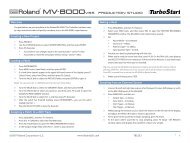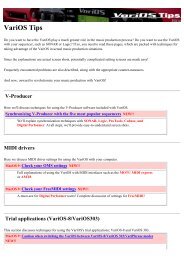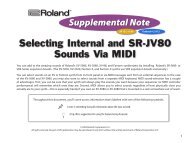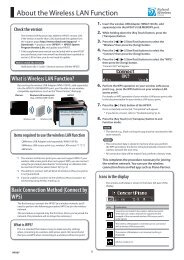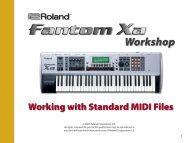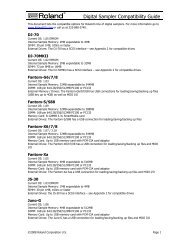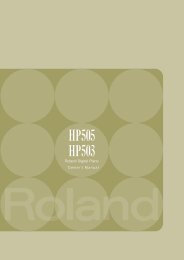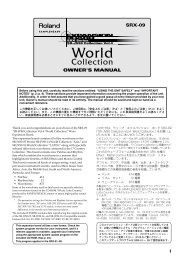Create successful ePaper yourself
Turn your PDF publications into a flip-book with our unique Google optimized e-Paper software.
Chapter 3. Creating Your Own Sounds<br />
The display will graphically indicate the selected Structure.<br />
The symbols displayed have the following meanings.<br />
W1 (WG1), W2 (WG2), F1 (TVF1), F2 (TVF2), A1 (TVA1), A2<br />
(TVA2), B (booster), R (ring modulator)<br />
* If you select a Tone while in the Structure display, the Tone that<br />
is paired with the selected Tone will also be selected.<br />
* If a Structure 2–10 is selected, turning off one Tone will cause<br />
the other Tone to be connected in the simple order of WG/TVF/<br />
TVA.<br />
Booster (Booster Gain)<br />
If the Type parameter has been set to 3 or 4, you can adjust<br />
how strongly the Booster will function. The Booster amplifies<br />
the incoming signal, causing it to distort. This creates an<br />
effect similar to the distortion often used on an electric<br />
guitar.<br />
■ Setting Effects for a Patch<br />
(EFFECTS)<br />
This group contains settings for the Multi-Effects/Chorus/<br />
Reverb effects used by a Patch.<br />
* If an “x” mark is displayed at the right of the display name, the<br />
effect for that display has been turned off. Turn the<br />
corresponding effect on before you make settings (p. 62).<br />
OUTPUT<br />
These parameters specify how the output of each Tone will<br />
be sent to the effects.<br />
* When the Type parameter (PATCH/COMMON/STRUCT) has<br />
a setting of 2–10, the outputs of Tones 1 (3) and 2 (4) will be<br />
combined with Tone 2 (4). This means that the setting for Tone<br />
1 (3) will be ignored.<br />
Ring Modulator<br />
The Ring Modulator multiplies two Tones together,<br />
creating a new sound that includes overtones<br />
(inharmonic overtones) that were not present in either<br />
of the two original Tones. Since the pitch difference<br />
between the two Tones will change the overtone<br />
structure, the result will be an unpitched metallic<br />
sound. This is especially suitable for creating bells and<br />
other metallic sounds.<br />
fig.3-26<br />
Output Assign (Output Assign/Output Level)<br />
Select whether or not the output of each Tone will be sent<br />
through Multi-Effects, and adjust the volume of each Tone.<br />
MIX: Output the Tone to the OUTPUT jack without passing<br />
through Multi-Effects.<br />
EFX: Output the Tone to the OUTPUT jack through Multi-<br />
Effects.<br />
* If you select MIX, the settings in the PATCH EFX OUT<br />
display (PATCH/EFFECTS) will be ignored.<br />
Chorus (Chorus Send Level)<br />
Adjust the amount of Chorus for each Tone.<br />
Chapter 3<br />
Reverb (Reverb Send Level)<br />
Adjust the amount of Reverb for each Tone.<br />
PATCH EFX TYPE<br />
Specify the Patch Multi-Effects.<br />
Type (EFX Type)<br />
Select the type of Multi-Effects. For details refer to “Multi-<br />
Effects Types (EFX Parameter)” (p. 93).<br />
PATCH EFX PRM (Patch EFX Parameters)<br />
Set the various parameters of the selected EFX type. For<br />
details refer to “Multi-Effects Types (EFX Parameter)” (p.<br />
93).<br />
71





